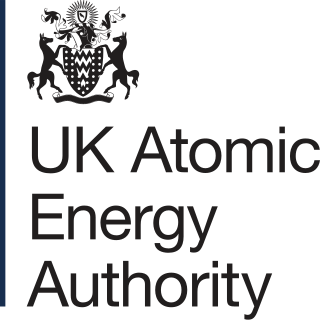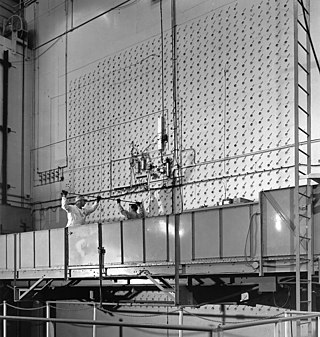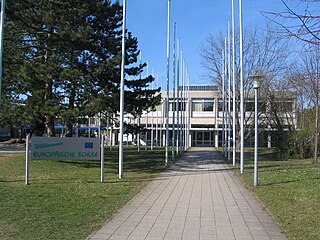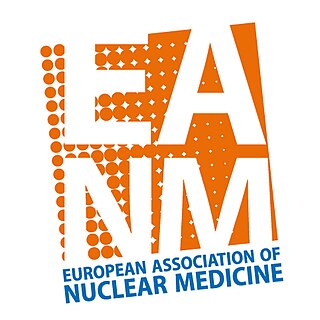
The International Atomic Energy Agency (IAEA) is an intergovernmental organization that seeks to promote the peaceful use of nuclear energy and to inhibit its use for any military purpose, including nuclear weapons. It was established in 1957 as an autonomous organization within the United Nations system; though governed by its own founding treaty, the organization reports to both the General Assembly and the Security Council of the United Nations, and is headquartered at the UN Office at Vienna, Austria.

The Manhattan Project was a research and development program undertaken during World War II to produce the first nuclear weapons. It was led by the United States in collaboration with the United Kingdom and Canada. From 1942 to 1946, the project was directed by Major General Leslie Groves of the U.S. Army Corps of Engineers. Nuclear physicist J. Robert Oppenheimer was the director of the Los Alamos Laboratory that designed the bombs. The Army program was designated the Manhattan District, as its first headquarters were in Manhattan; the name gradually superseded the official codename, Development of Substitute Materials, for the entire project. The project absorbed its earlier British counterpart, Tube Alloys, and subsumed the program from the American civilian Office of Scientific Research and Development. The Manhattan Project employed nearly 130,000 people at its peak and cost nearly US$2 billion, over 80 percent of which was for building and operating the plants that produced the fissile material. Research and production took place at more than 30 sites across the US, the UK, and Canada.

Antwerp Province, between 1815 and 1830 known as Central Brabant, is the northernmost province both of the Flemish Region, also called Flanders, and of Belgium. It borders on the North Brabant province of the Netherlands to the north and the Belgian provinces of Limburg, Flemish Brabant and East Flanders. Its capital is Antwerp, which includes the Port of Antwerp, the second-largest seaport in Europe. It has an area of 2,876 km2 (1,110 sq mi), and with over 1.92 million inhabitants as of January 2024, is the country's most populous province. The province consists of three arrondissements: Antwerp, Mechelen and Turnhout. The eastern part of the province comprises the main part of the Campine region.
Ununennium, also known as eka-francium or element 119, is a hypothetical chemical element; it has symbol Uue and atomic number 119. Ununennium and Uue are the temporary systematic IUPAC name and symbol respectively, which are used until the element has been discovered, confirmed, and a permanent name is decided upon. In the periodic table of the elements, it is expected to be an s-block element, an alkali metal, and the first element in the eighth period. It is the lightest element that has not yet been synthesized.

Mol is a municipality located in the Belgian province of Antwerp. The municipality only comprises the town of Mol. In 2021, Mol had a total population of 37,021 inhabitants. The total area is 114.19 km2. Mol is a popular holiday resort, with many lakes surrounded by woods. There are two main tourist lakes:

Dessel is a municipality located in the Belgian province of Antwerp. The municipality comprises only the town of Dessel proper. In 2021, Dessel had a total population of 9,659 inhabitants. The total area is 27.03 km2.
The European School, Culham (ESC) was one of the fourteen European Schools and the only one in the United Kingdom. Located in Culham near Abingdon in Oxfordshire. It was founded in 1978 for the purpose of providing an education to the children of staff working for the European Atomic Energy Community (Euratom).

The Nyongbyon Nuclear Scientific Research Center (녕변원자력연구소) is North Korea's major nuclear facility, operating its first nuclear reactors. It is located in Nyongbyon County in North Pyongan Province, about 100 km north of Pyongyang. The center produced the fissile material for North Korea's six nuclear weapon tests from 2006 to 2017, and since 2009 is developing indigenous light water reactor nuclear power station technology.

The United Kingdom Atomic Energy Authority is a UK government research organisation responsible for the development of fusion energy. It is an executive non-departmental public body of the Department for Energy Security and Net Zero (DESNZ).

SCK CEN, until 2020 shortened as SCK•CEN, is the Belgian nuclear research centre located in Mol, Belgium. SCK CEN is a global leader in the field of nuclear research, services, and education.
Now the NBL Program Office, the New Brunswick Laboratory (NBL), was a United States government-owned and operated, center of excellence in the measurement science of nuclear materials. It was established in 1949 by the Atomic Energy Commission and was located in New Brunswick, New Jersey. It was relocated between 1975 and 1977 and was located, as a Federal enclave, on the site of Argonne National Laboratory, about 40 kilometers (25 miles) southwest of Chicago, Illinois. NBL was part the Department of Energy's Office of Science Chicago Office.

The European School, Bergen is one of the thirteen European Schools. It is located in the town of Bergen in the Dutch province of North Holland. The school prioritises, for enrolment purposes, the children of European Union staff. Students must enrol in either the English, French or Dutch language sections of the school.

Kenneth Tompkins Bainbridge was an American physicist at Harvard University who worked on cyclotron research. His accurate measurements of mass differences between nuclear isotopes allowed him to confirm Albert Einstein's mass–energy equivalence concept. He was the Director of the Manhattan Project's Trinity nuclear test, which took place July 16, 1945. Bainbridge described the Trinity explosion as a "foul and awesome display". He remarked to J. Robert Oppenheimer immediately after the test, "Now we are all sons of bitches." This marked the beginning of his dedication to ending the testing of nuclear weapons and to efforts to maintain civilian control of future developments in that field.

Pakistan Atomic Energy Commission (PAEC) is a federally funded independent governmental agency, concerned with research and development of nuclear power, promotion of nuclear science, energy conservation and the peaceful use of nuclear technology.

The X-10 Graphite Reactor is a decommissioned nuclear reactor at Oak Ridge National Laboratory in Oak Ridge, Tennessee. Formerly known as the Clinton Pile and X-10 Pile, it was the world's second artificial nuclear reactor and the first designed and built for continuous operation. It was built during World War II as part of the Manhattan Project.
The Institute for Reference Materials and Measurements (IRMM), located in Geel, Belgium, is one of the seven institutes of the Joint Research Centre (JRC), a Directorate-General of the European Commission (EC).

Atomics International was a division of the North American Aviation company which engaged principally in the early development of nuclear technology and nuclear reactors for both commercial and government applications. Atomics International was responsible for a number of accomplishments relating to nuclear energy: design, construction and operation of the first nuclear reactor in California (1952), the first nuclear reactor to produce power for a commercial power grid in the United States (1957) and the first nuclear reactor launched into outer space by the United States (1965).

The European School Karlsruhe, commonly known as ESK, is one of three European Schools in Germany and one of thirteen across the European Union (EU). Founded in 1962, the school prioritises, for enrolment purposes, the children of staff of the European Commission's Joint Research Centre for Nuclear Safety and Security based nearby. Children of non-EU staff may enrol provided there is capacity. ESK is an all-through school catering for nursery, primary and secondary pupils, culminating in the awarding of the European Baccalaureate as its secondary leaving qualification.

The European Association of Nuclear Medicine (EANM) is the leading professional organisation for nuclear medicine in Europe. Established in 1985, the EANM serves as an umbrella organisation comprising national societies, affiliated societies and individual members working in nuclear medicine or related fields. It is also dedicated to the promotion of nuclear medicine amongst other medical learned societies, EU institutions like the European Union, international organisations like the International Atomic Energy Agency, and the general public.

Donk is a village in the municipality of Mol in the province of Antwerp in Belgium. Donk resides at the southern side of the Bocholt–Herentals Canal and is an industrial area, especially in past.
















